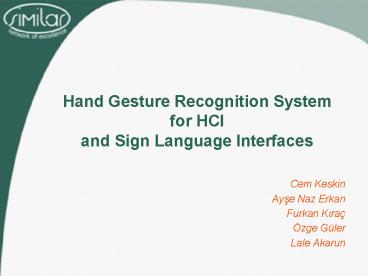Hand Gesture Recognition System for HCI and Sign Language Interfaces
1 / 8
Title:
Hand Gesture Recognition System for HCI and Sign Language Interfaces
Description:
3D from stereo vision using two web cams. Support for hand posture ... 3D Reconstruction: 3D reconstruction from stereo vision least squares approach ... –
Number of Views:588
Avg rating:3.0/5.0
Title: Hand Gesture Recognition System for HCI and Sign Language Interfaces
1
Hand Gesture Recognition Systemfor HCI and Sign
Language Interfaces
- Cem Keskin
- Ayse Naz Erkan
- Furkan Kiraç
- Özge Güler
- Lale Akarun
2
The System Overview
- Real-time gesture recognition system
- Marker based hand segmentation
- 3D from stereo vision using two web cams
- Support for hand posture recognition
- Modules to
- register the markers
- train the system,
- calibrate the cameras
- choose HCI commands to trigger for gestures
- support tracking of two hands
3
Methodology
2D Kalman Filter
3D Reconstruction
Marker Segmentation
3D Kalman Filter
Vector Quantizer
Right Image
Left Image
Gesture Spotter
Application
- Camera Calibration Special calibration object
using least squares approach - Marker Segmentation Hue based connected
components using double thresholding - 3D Reconstruction 3D reconstruction from stereo
vision least squares approach - Vector Quantization 15 codewords symbolizing 3D
spatial motion - Gesture Modeling Left-Right HMMs for gesture
modeling - Gesture Spotting A dynamic threshold HMM to
spot meaningful gestures - Gesture Training Baum-Welch algorithm to
estimate HMM parameters
4
Test Results
- We train the system with 8 3D gestures
- We bind the gestures to commands of a third
party Windows painting application and test the
recognition rates
- With 2 misclassifications out of 160 trials,
the system yields a recognition performance of
98.75
5
Improved Hand Tracking and Gesture Recognition
with Posture Information
- Advanced Hand Tracking
- Aim Robust hand tracking without using markers
- Considerations
- Different color spaces for connected components
algorithm - RGB, Normalized RGB, RGB Ratios, HSI, TSL, LUX,
CIE Lab and CIE Luv - Mean-Shift segmentation
- A kernel-based density estimation technique for
detection and clustering of the skin color - Particle Filters
- A method that tries to solve the generalized
tracking problem by approximation - Similar to genetic algorithm
- Overcomes restrictions of the Kalman filter
6
Hand Shape Recognition Module
- A module to identify the static pose of the hand
- Required for sign language or similar
applications - Also useful for HCI applications
- Our Approach
- Model based analysis of hand shapes minimize the
difference between a predefined model and the
input images - We use a genetic algorithm (GA) for global search
and the downhill-simplex method (DS) for local
search - The similarity measure for the model-input
matching is the non-overlapping areas of the
model silhouette and the hand region in the input
image - Hand Model
- A complete geometric hand model constructed with
simple quadrics, namely cylinders and spheres,
with 22 DOFs
7
Test Results
- POPULATION SIZE 600
- CROSSOVER 70
- MUTATION 8
- ELITICISM 8
- DS TOLERANCE 0.005
10 Generations of GA 25.13s DS 15.47s Population
Size 600 DS Tolerance 0.005
8 Generations of GA 20.84s DS 15.81s Population
Size 600 DS Tolerance 0.005
4 Generations of GA 5.28s DS 14.84s Population
Size 400 DS Tolerance 0.005
- For the general case, where all parameters are
estimated, this module doesnt work in real time - We will test the module for classification
problems with restricted subsets
8
Fusion of Hand Gesture and Posture Information
- We will convert the HMMs to Input/Output HMMs
- Take gesture codeword sequence as the output
sequence - Take pose information sequence as the conditional
input sequence - Several reasons to use IOHMMs instead of HMMs
- Disadvantages of HMMs
- Weak incorporation of context
- Ineffective coding of actual duration of gestures
and gesture parts - Not good for prediction
- Not good for synthesis for a visualization
module - IOHMMs overcome these problems
- Better learning of long term dependencies
- Effective modeling of duration
- Represent data with richer, non-linear models
- More discriminant training
- Current research area A dynamic threshold model
for IOHMMs































